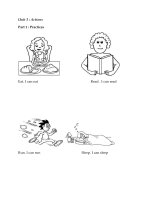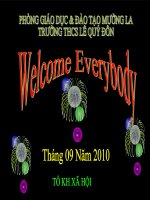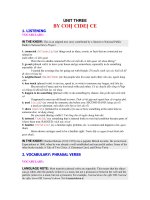Unit 3 Responsible Tourism Marketing And Communications
Bạn đang xem bản rút gọn của tài liệu. Xem và tải ngay bản đầy đủ của tài liệu tại đây (2.08 MB, 62 trang )
UNIT 3. RESPONSIBLE TOURISM
MARKETING AND COMMUNICATIONS
Picture source:
/>
Unit outline
Objectives
By the end of this unit, participants will be able to:
•
Describe the types of different dissemination channels for interaction with visitors
•
Explain the importance of marketing and communicating about Responsible Tourism
•
Explain the importance of authenticity and accuracy in marketing Responsible Tourism
•
Identify the types of sustainability marketing messages that can be delivered to tourists
2.
•
Explain the importance of customer data protection
3.
•
Describe the communication channels for disseminating Responsible Tourism provisions
Topics
1.
4.
5.
Importance of responsible marketing
and communications in tourism
Communicating authentic and accurate
messages
Marketing and communicating
sustainable practices
Maintaining data privacy in marketing
Collecting visitor feedback
UNIT 3. RESPONSIBLE TOURISM MARKETING & COMMUNICATIONS
TOPIC 1. Importance of RESPONSIBLE MARKETING & COMMUNICATIONS IN
TOURISM
The role and function of marketing and communications
Management
Management
process
process
Engages
Engages audiences
audiences
Aims
Aims for
for attitudinal
attitudinal
or
or behavioural
behavioural
response
response
Presents
Presents messages
messages
The marketing and communications mix
Advertising
Promotions
g
Direct marketin
lati
Public re
Personal selling
on s
The “4P” marketing mix
Products in tourism marketing
•
•
•
The goods and services that enable the tourism process
The combination of products creates a visitor “experience”
Common types of products include:
–
–
–
–
–
–
Accommodation
Attractions
Transport
Recreation
Shopping
Restaurants
Pricing in tourism marketing
•
•
Refers to the amount charged for a tourism product
•
•
•
May be adjusted for different circumstances
•
Cost of end product as well as at points along
distribution chain
Regulated through conditions
Amount should consider operating costs, profit margin
and distribution network costs
Other influences include demand, seasonality, target
market, and competitors
Place in tourism marketing
•
•
The link between the product and the consumer
•
•
Direct or through distribution channels
Considers where and how a consumer may make a purchase
decision
Choice of distribution depends on factors like:
–
–
–
purchasing behaviour of target market
associated costs
distributor familiarity and enthusiasm of the product
Promotion in tourism marketing
•
•
•
Aims to influence, inform, and / or persuade
Usually a mix of:
–
–
–
–
Advertising
Public Relations
Personal selling
Sales Promotions
Promotional mix depends on consumer profile - what do they read, where do they go, who
influences them..?
The 5th P - Packaging
•
•
•
•
Combines two or more products and /or services to:
1.
2.
Make them easier to buy (convenience)
Provide consumers with well priced, attractive and convenient
holiday options (price advantage)
Other consumer benefits include ease of payment and
planning and less stress
Used to target specific markets and explore new ones
Fosters partnerships building of tourism operators for
mutual benefit
Applying principles of responsibility to marketing and communication
•
•
•
•
•
Respects law and good practice
Decent and honest
Respects fair competition
Has sense of social responsibility
Respects user privacy
3 key components of responsibility in tourism marketing and communications
SELL PRODUCTS FAIRLY
INFORM ABOUT
DESTINATIONS
TRUTHFULLY
RAISE AWARENESS
ABOUT
SUSTAINABILITY
Benefits of responsible tourism marketing and communication
Creates competitive advantage
Increases value and demand
Increases customer loyalty
Increases customer satisfaction
Facilitates more respectful interaction in destinations
UNIT 3. RESPONSIBLE TOURISM MARKETING AND COMMUNICATIONS
TOPIC 2. communicating
authentic and accurate messages
Tourism experiences involve…
INFLUENCES:
Place
Infrastructure
Demand
Services
Motivation
TOURIST
EXPERIENCE
Others?
Interpretation
Authenticity
Types of tourists
Authenticity in tourism experiences
•
•
Travel to experience something unique or original
•
While authenticity is perceived..
..it remains highly connected to
marketing tourism experiences
•
Integrity can relate to a place, an
object or an activity
Services nature of tourism and
component parts make marketing susceptible to inaccurate messages
Picture source:
/>
Examples of inauthentic advertising from around the world
Sharing a bottle of wine
on the beach…really?
The Mediterranean
Sea has never looked
this good!
Are we in Spain or the
Carribbean!?
Picture sources:
/> /> />
Testing the ethics of
proposed marketing actions
TEST
QUESTION
Legal Test
Does the contemplated action violate the law?
Duties Test
Is this action contrary to widely accepted moral obligations?
Special Obligations Test
Does the proposed action violate any other special obligations that stem from the type of marketing organisation at focus?
Motives Test
Is the intent of the contemplated action harmful?
Consequences Test
Is it likely that any major damages to people or organisations will result from the contemplated action?
Utilitarian Test
Is there a satisfactory alternative action that produces equal or greater benefits to the parties affected than the proposed action?
Rights Test
Does the contemplated action infringe on property rights, privacy rights, or the inalienable rights of the consumer?
Justice Test
Does the proposed action leave another person or group less well off? Is this person or group already a member of a relatively underprivileged class?
Source: Laczniak, G.R. & Murphy , P.E. 1993, Ethical Marketing Decisions: The Higher Road, Allyn and Bacon, Needham Heights, MA, USA in Dunfee, T.W., Craig Smith, N. and Ross, W.T. 1999, ‘Social contracts and marketing ethics’, Journal of Marketing, 63(3): 14-32)
Commodification of culture
•
•
The manufacturing and selling of culture for profit
•
•
May result in the loss of original meaning
Response to fulfilling demand for perceived
authenticity
Imperative to ensure involvement and determination
of local people
Picture source:
/>
4 examples of cultural commodification in tourism
Redeveloping places to make them more attractive for tourist consumption
Creating staged and reshaped traditional performances for tourists
Adaptive reuse of historical buildings without interpretation
Sale and / or reproduction of artefacts of cultural or spiritual significance as
souvenirs
Picture sources:
/> /> /> />
Greenwashing
•
Knowingly misleading consumers about a product or service’s environmental practices or
benefits for own gain
CAUSES
•
•
•
•
Sector’s
Sector’s intensity
intensity in
in resource
resource use
use
Largely
Largely unregulated
unregulated nature
nature of
of the
the sector
sector
Sector
Sector composition
composition and
and competition
competition
EFFECTS
Consumer
Consumer demand
demand
•
•
Erosion
Erosion of
of public
public trust
trust of
of tourism
tourism eco-labels
eco-labels
Reputational
Reputational damage
damage
Greenwashing is all around us
but can be hard to spot
Example 1
Example 2
•
•
A hotel chain claims to be environmentally friendly because
A well-known international fast food restaurant chain tried
they allow guests to choose whether to sleep on the same
to paint itself as ‘green’ just because it had begun to use
sheets and use the same towels for continuous days. While
biofuel made from leftover grease in its fleet of trucks as
the idea is good it is not making a significant difference.
well as using recycled paper in its takeaway bags. However
More impact can be made by installing for example,
the company still uses beef grazed on deforested land in
motion-sensor lighting, more efficient insulation and
South America, and bases its entire concept around
heating, or purchasing non-toxic carpeting and bedding.
disposable packaging.
Source: Marie C. 2013, ‘Misleading Marketing: Beware the Greenwash!’, Elux Magazine, Feb 12, 2013
The “7 Sins” of tourism promotion
Irrelevance
Lesser of two evils
•
Fibbing
•
•
The hidden trade-of
SIN 5.
•
No proof
SIN 2.
SIN 6.
•
Vagueness
SIN 3.
SIN 7.
•
Worshiping false labels
SIN 4.
•
SIN 1.
Source: Kuehnel J. 2011, ‘Greenwashing in the Travel and Tourism Industry’, Toronto Sustainability Series, Available [online]:
Accessed: 21/01/2014
More satisfied visitors; fewer complaints
•
Enhanced reputation
•
Increased sales and income
•
Fewer negative social, economic and environmental impacts
•
authentically
The key benefits of marketing products and experiences accurately and









